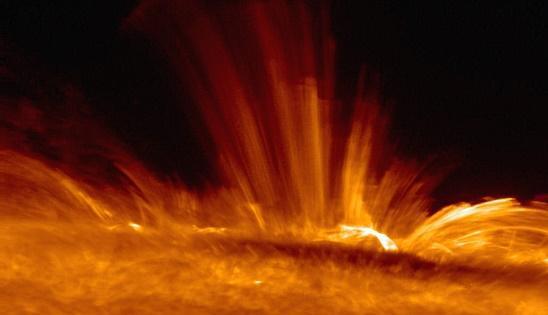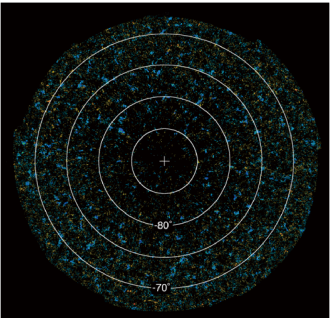Since Hinode was launched, it has achieved many major discoveries to help solve the mysteries of the Sun. Here we introduce some of those discoveries.
The Riddle of Why the Solar Surface Temperature is 6,000 K while the Upper Atmosphere (Corona) is 1,000,000 K

The structure and temperature of the solar atmosphere (©ISAS / JAXA)
The temperature of the solar surface (photosphere) is 6,000 K; the temperature of the chromosphere which is above the surface is around 10,000 K; and the temperature of the corona which exists above the chromosphere is around 1,000,000 K. From this, you can see that in the solar atmosphere, the outer layers have higher temperatures. The energy that makes the Sun shine is generated in the center of the Sun (core) and diffuses out in all directions. Therefore, this temperature reversal phenomenon that the further you get from the solar surface the higher the temperature becomes, is a very mysterious phenomenon. It would be like if it became hotter as you moved away from a bonfire or stove. How is the corona heated? - This mystery is called the "coronal heating problem" and it has been one of the major problems of solar physics for many years.
Do Magnetic Waves Heat the Solar Corona?
It is known that magnetic fields play important roles in the coronal heating problem. There are various hypotheses for the mechanism of corona heating through magnetic fields. Among them, one of the leading hypotheses is the "wave heating theory." In this theory, the waves propagating along magnetic lines of force carry energy to the corona, and the corona heats up by converting the wave energy into thermal energy.
Hinode Captured the Waves!
Hinode produced observational results which might prove that this theory is correct.
First of all, in 2007, Hinode found waves travelling along the magnetic lines of force. Please watch the arrows in the movie. Known as a prominence, pieces of chromospheric atmosphere floating in the high temperature corona undulate up and down. Since the plasma has the property that it moves along magnetic lines of force, the vertical oscillation of the plasma in a prominence is thought to be due to the waves traveling along the magnetic lines of force. The fluctuation of a prominence is a very small movement, so it can be said that these results were achieved because Hinode enabled unprecedented atmospheric-interference-free, high-spatial-resolution observations from outer space. (The details can be found here.)
The Hinode Solar Optical Telescope captured waves travelling through the prominence.
(© JAXA / NAOJ)
Revealing the Process that Changes Wave Energy to Heat
Just because we discovered waves, we cannot assert that they really heat the corona. The waves need to transmit energy to the corona and that energy must be converted to thermal energy in the corona. In 2015, a process for wave energy converting to heat in the corona was suggested by the combination of observations and theory. It was shown that there is a high possibility that a prominence is heated by resonant absorption followed by turbulence generation. This result integrated the results of collaborative observations using Hinode and the U.S. solar observation satellite IRIS with numerical simulations using NAOJ 's supercomputer "ATERUI". (The details can be found here.)
Proving the Corona Heating Source is in the Lower Corona
Hinode showed that an important location for heating the corona is the area around the lower corona. Spectroscopy observations of the emission lines emerging from the corona were performed with the Extreme-ultraviolet Imaging Spectrometer. We were able to perform spectroscopic observation of the corona with remarkably higher resolution and higher sensitivity than before. Therefore, we created a velocity map of the depth (line of sight) direction in the active region corona, as shown in the figure below, and for the first time captured the upward flow of plasma near the base of the coronal loop. It can be said this indicates that the mechanism to heat the corona is working in the lower corona.

Images of an active region corona (left) and its velocity map in the depth direction (right).
(© NAOJ / JAXA)
Dynamically Active Chromosphere
Although Yohkoh's observations showed that the corona is dynamically active, many researchers were expecting the chromosphere to be a calm region, unlike the corona. But contrary to their expectations, Hinode has discovered a dynamically moving chromosphere. Around sunspots, it has been clearly shown that the plasma dynamically erupts up to the corona, the upper atmosphere. Ground-based telescopes are affected by atmospheric fluctuations, so it is very difficult to capture fine and sudden jet phenomena clearly. It can be said that this result demonstrated the power of Hinode as an orbiting solar observatory. Then, it came to be thought that the dynamic activity phenomena of the chromosphere play an important role in the coronal heating.

The dynamically active chromosphere. (© NAOJ / JAXA)
Predicting Explosive Phenomena (Flares) on the Sun
The Hinode Solar Optical Telescope enabled precise measurements of the magnetic field and made it possible to verify the magnetic field structure which triggers solar flares by comparing simulation models to actual observations.
In addition, it has become possible to calculate how much magnetic energy is stored in the corona estimating the coronal magnetic fields more accurately through the precise measurement of magnetic field structures in the photosphere.
On the other hand, Hinode has also made achievements in studies to elucidate the details of magnetic reconnection which is thought to be the "engine" driving solar flares. In magnetic reconnection, the energy stored in the magnetic field changes into heat and plasma motions, resulting in high-speed plasma flows. The Hinode Extreme-ultraviolet Imaging Spectrometer found these high-speed plasma flows through spectroscopic observations.
Magnetic Field Created Inside the Sun
Discovery of a Strong Magnetic Field in the Solar Polar Regions
Sunspots are regions of very strong magnetic fields. The Sun can be called a star tangled in magnetic fields. How is this magnetic field created inside the Sun? The Sun is a mass of plasma (charged particles). When the plasma moves, it is the same as an electrical current flowing. This means that a magnetic field is generated. Electrical current flows along the east-west direction by solar rotation, so a magnetic field is generated in the north-south direction. However, this alone cannot explain the magnetic field of sunspots. The rotational velocity of the Sun slows from the equator towards the poles (this is called differential rotation). The magnetic field in the north-south direction gets wrapped around the Sun because the magnetic lines of force near the equator stretch out gradually due to the differential rotation. Therefore, this is believed to form magnetic lines of force in the same direction as the Sun's rotation. It is thought that some of these magnetic lines of force rise up to the solar surface forming sunspots. In this process, it is the magnetic field in the north-south direction before being twisted by the differential rotation that determines the strength of the sunspots' magnetic field and the number of sunspots. And, the polar regions are thought to be the only places where part of this magnetic field appears on the solar surface. Thus, it is very important to know about the polar magnetic field in order to know about the subsequent magnetic activity that prevails on the whole solar surface.
However, when observing the polar regions from the orbital plane of the Earth, we have to observe the surface at an extremely oblique angle, so it is very difficult to distinguish detailed characteristics. Hinode's high resolution made it possible to conduct investigations using even oblique observations.
As a result, Hinode found strong magnetic fields in the solar polar regions. Until then, it had been thought that only weak and diffuse magnetic fields existed in the polar regions.
But, the Hinode Solar Optical Telescope discovered that strong magnetic fields, which exceed 1,000 Gauss (0.1 Tesla) similar to the sunspots, exist as compact magnetic patches throughout the polar regions. (The details can be found here.)

Magnetic field strength distribution map of the solar south pole in April 2012.
The blue dots represent north polarity, and the red dots represent south polarity. (© NAOJ / JAXA)
Discovery of Transient Horizontal Magnetic Fields
Meanwhile, it was suggested that the convective movement of plasma may cause small scale magnetic fields. The Hinode Solar Optical Telescope discovered that these magnetic fields cover the whole Sun. These magnetic fields are much smaller and have shorter lifetimes than sunspots. In addition they point horizontally along the solar surface. These magnetic fields are called transient horizontal magnetic fields. This result was made possible by Hinode's high precision spectro-polarimetry. Since these magnetic fields exist everywhere on the Sun, the total amount of their energy becomes potentially enormous, and there is a possibility that this could provide the energy for the coronal heating. (The details can be found here.)
Regarding the use of images and movies on the page concerned, please visit the page here. The credits of images and movies on this page are “NAOJ/JAXA” unless explicitly stated to the contrary. Regarding images and movies on this page the credits of which are “NAOJ/JAXA”, "NAOJ/JAXA/MSU", or “NAOJ, JAXA, NASA/MSFC”, terms of use for Copyrighted Works owned by NAOJ can be applied. In using the images and movies, the credits should be given.
